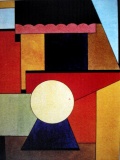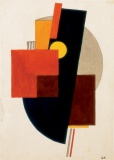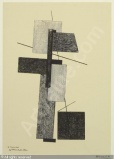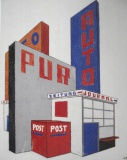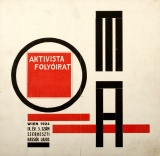Difference between revisions of "Lajos Kassák"
Jump to navigation
Jump to search
| (20 intermediate revisions by the same user not shown) | |||
| Line 2: | Line 2: | ||
|image = Lajos_Kassak_in_Vienna_ca_1922.jpg | |image = Lajos_Kassak_in_Vienna_ca_1922.jpg | ||
|imagesize = 250px | |imagesize = 250px | ||
| − | |caption = | + | |caption = Kassák in Vienna, c1922. |
|birth_date = {{birth date|1887|3|21|mf=y}} | |birth_date = {{birth date|1887|3|21|mf=y}} | ||
| − | |birth_place = | + | |birth_place = Érsekújvár, Austria-Hungary (now Nové Zámky, Slovakia) |
|death_date = {{Death date and age|1967|7|22|1887|3|21|mf=y}} | |death_date = {{Death date and age|1967|7|22|1887|3|21|mf=y}} | ||
| − | |death_place = [[ | + | |death_place = Budapest, [[Hungary]] |
| + | |web = [[Wikipedia::http://en.wikipedia.org/wiki/Lajos_Kassák|Wikipedia]] | ||
| + | |collections = [[MoMA::{{MoMA|3010}}|MoMA]] | ||
}} | }} | ||
| − | + | <onlyinclude>[[Lajos Kassák]] (1887–1967) was a Hungarian poet, novelist, painter, essayist, editor, and theoretician of the avant-garde.</onlyinclude> | |
| − | |||
| − | |||
| − | <onlyinclude>[[Lajos Kassák]] | ||
| − | Born | + | {{TOC limit|3}} |
| + | |||
| + | ==Chronology== | ||
| + | ''Based on the panel at permanent exhibition in the Kassák Museum, Budapest; there compiled from biographical text by Ferenc Csaplár.'' | ||
| + | |||
| + | <div class="dpl" style="-moz-column-count:2; -webkit-column-count:2; column-count:2; font-size:.95em"> | ||
| + | * 1887: Born in Érsekújvár, Austria-Hungary. | ||
| + | * 1900: Leaves school for apprenticeship as locksmith. | ||
| + | * 1904: Moves to Budapest and starts working in factories in Angyalföld and Újpest. Participates in trades union political campaigns and joins Hungarian Social Democratic Party. | ||
| + | * 1908: First poem published in the weekly ''Újpest''. | ||
| + | * 1909: Sets out for Western Europe on foot, with no money. Discovers art in the museums. Returns to Budapest in December. | ||
| + | * 1915: Founds anti-militarist periodical ''[[A Tett]]'' [The Action]. | ||
| + | * 1916: The international issue of ''[[A Tett]]'' appears with contributions from writers and artists from countries at war with the monarchy, and the periodical is banned. Launches a new periodical ''[[MA]]'' [Today]. | ||
| + | * 1919: During Hungarian Soviet Republic enters into dispute with Commissar Bela Kun over avant-garde art and the independence of art from politics. ''[[MA]]'' subsequently prevented from appearing. After the failure of the Soviet Republic spends five months in prison. | ||
| + | * 1920: After his release, leaves the country for exile in Vienna. Relaunches ''[[MA]]'', formulates the theoretical basis of Hungarian constructivism and develops wide contacts with European avant-garde movements. | ||
| + | * 1926: Returns to Hungary and starts up new journal, ''[[Dokumentum]]'' [Document] which lasts for one year. | ||
| + | * 1928: Launches a new, independent, left-wing journal ''[[Munka]]'' [Work] and associated movement. | ||
| + | * 1928-34: Leader of a socially-aware educational society of students and workers, grouped around ''[[Munka]]''. Writes regularly for the newspapers ''Népszava'' [People's Voice] and ''Szocializmus'' [Socialism], protesting against Stalinist tyranny and extreme right-wing movements. | ||
| + | * 1939: Exhibits in the Galerie Charpentier, Paris. A new law restricting press freedom closes down ''[[Munka]]''. | ||
| + | * 1940-45: Publishes several novels, books of reports and books of verse. In 1940, an anti-war poem causes him to be imprisoned for two months under a 1937 court judgement. | ||
| + | * 1945: After the war takes on several positions in cultural affairs in the new political climate. Edits the relaunched ''Új Idők'' [New Times] and then the ''Alkotás'' [Art] and ''Kortárs'' [The Contemporary]. | ||
| + | * 1948: His journals are closed down, he is excluded from public affairs, and his poems and articles cannot be published. | ||
| + | * 1956: Stands up for the Revolution, returns to artistic affairs. | ||
| + | * 1957: Public involvement limited, but his old writing begins to be republished. | ||
| + | * 1960: Exhibition of his work in the Galerie Denise René in Paris, resumption of his international career. Still ignored as an artist in Hungary. | ||
| + | * 1965: Awarded Kossuth Prize for his poetry. | ||
| + | * 1967: Holds the last exhibition in his life in the Adolf Fényes Room in Budapest, at his own expense. | ||
| + | </div> | ||
==Works== | ==Works== | ||
<gallery> | <gallery> | ||
| − | File:Lajos_Kassak_ET_1921.jpg|''ET'', 1921 | + | File:Lajos_Kassak_ET_1921.jpg|''ET'', 1921. Gouache, paper. |
| − | File:Lajos_Kassak_Volkstuemliche_Motive_ca_1921.jpg|''Volkstümliche Motive'', | + | File:Lajos_Kassak_Volkstuemliche_Motive_ca_1921.jpg|''Volkstümliche Motive'', c1921. Gouache on paper. |
| − | File:Lajos_Kassak_Laszlo_Moholy-Nagy_Buch_Neuer_Kuenstler_1922.jpg| | + | File:Lajos_Kassak_Laszlo_Moholy-Nagy_Buch_Neuer_Kuenstler_1922.jpg|Cover of ''Buch Neuer Künstler'', Vienna, 1922. |
| − | File: | + | File:Kassak_Lajos_1922_Picture Architecture.jpg|''Képarchitektúra'' [Picture Architecture], 1922. Gouache on paper. 26 x 20 cm. [http://www.kieselbach.hu/alkotas/keparchitektura_-1922_11915] |
| − | File:Kassak_Lajos_Bildarchitektur.jpg|''Bildarchitektur'' | + | File:Kassak_Lajos_Bildarchitektur.jpg|''Bildarchitektur''. Silkscreen on thin cardboard. |
| − | + | Kassak_Lajos_1922_Bildarchitektur_II.jpg|''Bildarchitektur II (Entwurf eines Kiosks)'', 1922. Gouache, cardboard. | |
| − | File:Lajos_Kassak_Bildarchitektur Kiosk 1923.jpg|''Bildarchitektur'' [Kiosk], 1923 | + | File:Lajos_Kassak_Bildarchitektur Kiosk 1923.jpg|''Bildarchitektur'' [Kiosk], 1923. Gouache, ink, paper. |
File:Lajos_Kassak_Titelblatt_der_Zeitschrift_MA_1924.jpg|''MA'' journal, cover, 1924. | File:Lajos_Kassak_Titelblatt_der_Zeitschrift_MA_1924.jpg|''MA'' journal, cover, 1924. | ||
File:Lajos_Kassak_To_Kino_1928.jpg|''Tó Mozi'' [Tó Kino], 1928. | File:Lajos_Kassak_To_Kino_1928.jpg|''Tó Mozi'' [Tó Kino], 1928. | ||
| − | File:Lajos_Kassak_Buehnenbild Munka.jpg|''Bühnenbild Munka'' | + | File:Lajos_Kassak_Buehnenbild Munka.jpg|''Bühnenbild Munka''. |
</gallery> | </gallery> | ||
| + | |||
| + | ==Portraits== | ||
| + | <gallery> | ||
| + | Lajos_Kassak_in_Budapest_1927-28.jpg|in Budapest, c1927-28. | ||
| + | Lajos_Kassak_1930.jpg|Photo by Lajos Lengyel, 1930. | ||
| + | Lajos_Kassak_in_Budapest_1964.jpg|in Budapest, 1964. | ||
| + | </gallery> | ||
| + | |||
| + | ==Publications== | ||
| + | ; Magazines | ||
| + | * editor, ''[[A Tett]]'', 17 numbers, 1915-16. | ||
| + | * editor, ''[[MA]]'', 76 numbers, Budapest (1916-19) and Vienna (1919-25), 1916-25. | ||
| + | * editor, ''[[Akasztott Ember]]'', 5 numbers, Vienna, 1922-23. | ||
| + | * editor, ''[[Dokumentum]]'', 5 numbers, Budapest, 1926-27. | ||
| + | * editor, ''[[Munka]]'', 65 numbers, Budapest, 1928-39. | ||
| + | |||
| + | ; Books | ||
| + | * ''[http://digital.lib.uiowa.edu/cdm/compoundobject/collection/dada/id/30979/rec/106 Novellaskonyv: Válogatott novellák 1911-1919]'', Vienna: Bán-Verlag, 1921, 123 pp. {{hu}} | ||
| + | * editor, with Lászlo Moholy-Nagy, ''Buch neuer Künstler'', Vienna and Budapest: Aktivista Foliorat, 1922. An anthology of modern art and poetry. [http://www.lars-mueller-publishers.com/de/catalogue-art/buch-neuer-kunstler] {{de}} | ||
| + | ** ''Új művészek könyve'', Bécs, 1922; repr., Budapest: Európa-Corvina, 1977, 104 pp. [http://labor.c3.hu/1977/01/uj-muveszek-konyve/] {{hu}} | ||
| + | * ''[http://library.hungaricana.hu/en/view/ORSZ_PIMU_KasMuz_52/ MA Buch. Gedichte]'', trans. & intro. Andreas Gáspár, Berlin: Der Sturm, 1923; facs., Budapest: Kassák Múzeum, 1999. {{de}} | ||
| + | * ''Kôň zomrie, vtáky sa rozletia'', trans. Vojtěch Kondrót, Bratislava: Slovenský spisovateľ, 1971. Poems. {{sk}} | ||
| + | * [http://www.avantgarde-museum.com/en/museum/collection/4445-KASSAK-LAJOS/#works more] | ||
| + | |||
| + | ==Catalogues== | ||
| + | * ''[http://library.hungaricana.hu/en/view/ORSZ_PIMU_KasMuz_29/ Kassák]'', eds. Ferenc Csaplár, Mariann Gergely, Péter György, and Gábor Pataki, Budapest: Magyar Nemzeti Galéria & Petőfi Irodalmi Múzeum, 1987. {{hu}} | ||
| + | * Szász János, Kovács Tamás, ''[http://library.hungaricana.hu/en/view/ORSZ_PIMU_KasMuz_vegyes/ Lappangó elem]'', Budapest: Kassák Museum, 1991. {{hu}} | ||
| + | * ''[http://library.hungaricana.hu/en/view/ORSZ_PIMU_KasMuz_37/ Kassák Lajos: Érsekújvár]'', ed. Ferenc Csaplár, Budapest: Kassák Múzeum, 1992. {{hu}} | ||
| + | * ''[http://library.hungaricana.hu/en/view/ORSZ_PIMU_KasMuz_60/ Kassák Lajos: Reklám és modern tipográfia]'', ed. Ferenc Csaplár, Budapest: Kassák Múzeum, 1999. {{hu}} | ||
| + | ** ''[http://library.hungaricana.hu/en/view/ORSZ_PIMU_KasMuz_61/ Lajos Kassák: Reklame und moderne Typografie]'', ed. Ferenc Csaplár, Budapest: Kassák Museum, 1999. {{de}} | ||
| + | ** ''[http://library.hungaricana.hu/en/view/ORSZ_PIMU_KasMuz_65/ Lajos Kassák: The Advertisement and Modern Typography]'', ed. Csaplár Ferenc, Budapest: Kassák Múzeum, 1999. {{en}} | ||
| + | * ''Lajos Kassák. Botschafter der Avantgarde 1915-1927'', Budapest: Literaturmuseum Petőfi & Kassák Museum, 2011, 101 pp. [http://www.berlinischegalerie.de/en/exhibitions/archives/2011/lajos-kassak/] {{de}} | ||
| + | |||
| + | ==Literature== | ||
| + | * Endre Gáspár, ''Kassák Lajos - az ember és munkája'', Bécs, 1924. {{hu}} | ||
| + | * Tomáš Štrauss, ''Kassák. Ein ungarischer Beitrag zum Konstruktivizmus'', Cologne, 1975. {{de}} | ||
| + | * Emőke G. Komoróczy, ''[http://mek.oszk.hu/01300/01372/01372.pdf Kassák és a magyar avantgárd mozgalom]'', 1995, 137 pp. {{hu}} | ||
| + | * Marian Mazzone, [http://epa.oszk.hu/00000/00010/00038/pdf/HSR_2004_1-2_015-046.pdf "Dadaist Text / Constructivist Image: Kassák's ''Képarchitektúra''"], ''Hungarian Studies Review'' 31:1-2 (2004). {{en}} | ||
| + | * Zoltán Péter, ''Lajos Kassák, Wien und der Konstruktivismus 1920-1926'', Frankfurt am Main: Peter Lang, 2010, 316 pp. [http://books.google.com/books?id=p2gNS61SrhwC&printsec=frontcover]. Review: [http://www.kakanien-revisited.at/rez/PDereky1.pdf Deréky] (Kakanien 2010). {{de}} | ||
| + | * ''[http://library.hungaricana.hu/en/view/ORSZ_PIMU_KasMuz_01/ ...fejünkből töröljük ki a regulákat" Kassák Lajos az író, képzőművész, szerkesztő és közszereplő]'', ed. Andrási Gábor, Budapest: Petőfi Irodalmi Múzeum & Kassák Alapítvány, 2010. {{hu}} | ||
==See also== | ==See also== | ||
* [[Hungary#Avant_garde]] | * [[Hungary#Avant_garde]] | ||
| − | * [[ | + | * [[Central_and_Eastern_Europe#Constructivists.2C_Futurists|Central and Eastern Europe#Constructivists, Futurists]] |
| − | == | + | ==Links== |
| − | * http://www. | + | * [http://www.kassakmuzeum.hu The Kassák Museum and the Kassák Foundation], Budapest. |
| − | * http://www. | + | * [http://www.kassakmuzeum.hu/en/index.php?p=lajos_kassak Biography on the website of the Kassák Museum]. |
* http://musessquare.blogspot.com/2011/03/kassak-lajos.html | * http://musessquare.blogspot.com/2011/03/kassak-lajos.html | ||
* http://www.hunlit.hu/kassaklajos,en | * http://www.hunlit.hu/kassaklajos,en | ||
* http://www.artpool.hu/Kassak/Kassak_quotationshu.html | * http://www.artpool.hu/Kassak/Kassak_quotationshu.html | ||
* http://www.artpool.hu/Poetry/soundimage/Kassak.html | * http://www.artpool.hu/Poetry/soundimage/Kassak.html | ||
| + | * http://www.artnet.com/artists/lajos-kassák/past-auction-results | ||
| − | [[Category:Constructivism | + | [[Category:Constructivism]] {{DEFAULTSORT:Kassak, Lajos}} |
Revision as of 15:24, 25 September 2017
 Kassák in Vienna, c1922. | |
| Born |
March 21, 1887 Érsekújvár, Austria-Hungary (now Nové Zámky, Slovakia) |
|---|---|
| Died |
July 22, 1967 (aged 80) Budapest, Hungary |
| Web | Wikipedia |
| Collections | MoMA |
Lajos Kassák (1887–1967) was a Hungarian poet, novelist, painter, essayist, editor, and theoretician of the avant-garde.
Chronology
Based on the panel at permanent exhibition in the Kassák Museum, Budapest; there compiled from biographical text by Ferenc Csaplár.
- 1887: Born in Érsekújvár, Austria-Hungary.
- 1900: Leaves school for apprenticeship as locksmith.
- 1904: Moves to Budapest and starts working in factories in Angyalföld and Újpest. Participates in trades union political campaigns and joins Hungarian Social Democratic Party.
- 1908: First poem published in the weekly Újpest.
- 1909: Sets out for Western Europe on foot, with no money. Discovers art in the museums. Returns to Budapest in December.
- 1915: Founds anti-militarist periodical A Tett [The Action].
- 1916: The international issue of A Tett appears with contributions from writers and artists from countries at war with the monarchy, and the periodical is banned. Launches a new periodical MA [Today].
- 1919: During Hungarian Soviet Republic enters into dispute with Commissar Bela Kun over avant-garde art and the independence of art from politics. MA subsequently prevented from appearing. After the failure of the Soviet Republic spends five months in prison.
- 1920: After his release, leaves the country for exile in Vienna. Relaunches MA, formulates the theoretical basis of Hungarian constructivism and develops wide contacts with European avant-garde movements.
- 1926: Returns to Hungary and starts up new journal, Dokumentum [Document] which lasts for one year.
- 1928: Launches a new, independent, left-wing journal Munka [Work] and associated movement.
- 1928-34: Leader of a socially-aware educational society of students and workers, grouped around Munka. Writes regularly for the newspapers Népszava [People's Voice] and Szocializmus [Socialism], protesting against Stalinist tyranny and extreme right-wing movements.
- 1939: Exhibits in the Galerie Charpentier, Paris. A new law restricting press freedom closes down Munka.
- 1940-45: Publishes several novels, books of reports and books of verse. In 1940, an anti-war poem causes him to be imprisoned for two months under a 1937 court judgement.
- 1945: After the war takes on several positions in cultural affairs in the new political climate. Edits the relaunched Új Idők [New Times] and then the Alkotás [Art] and Kortárs [The Contemporary].
- 1948: His journals are closed down, he is excluded from public affairs, and his poems and articles cannot be published.
- 1956: Stands up for the Revolution, returns to artistic affairs.
- 1957: Public involvement limited, but his old writing begins to be republished.
- 1960: Exhibition of his work in the Galerie Denise René in Paris, resumption of his international career. Still ignored as an artist in Hungary.
- 1965: Awarded Kossuth Prize for his poetry.
- 1967: Holds the last exhibition in his life in the Adolf Fényes Room in Budapest, at his own expense.
Works
Képarchitektúra [Picture Architecture], 1922. Gouache on paper. 26 x 20 cm. [1]
Portraits
Publications
- Magazines
- editor, A Tett, 17 numbers, 1915-16.
- editor, MA, 76 numbers, Budapest (1916-19) and Vienna (1919-25), 1916-25.
- editor, Akasztott Ember, 5 numbers, Vienna, 1922-23.
- editor, Dokumentum, 5 numbers, Budapest, 1926-27.
- editor, Munka, 65 numbers, Budapest, 1928-39.
- Books
- Novellaskonyv: Válogatott novellák 1911-1919, Vienna: Bán-Verlag, 1921, 123 pp. (Hungarian)
- editor, with Lászlo Moholy-Nagy, Buch neuer Künstler, Vienna and Budapest: Aktivista Foliorat, 1922. An anthology of modern art and poetry. [2] (German)
- Új művészek könyve, Bécs, 1922; repr., Budapest: Európa-Corvina, 1977, 104 pp. [3] (Hungarian)
- MA Buch. Gedichte, trans. & intro. Andreas Gáspár, Berlin: Der Sturm, 1923; facs., Budapest: Kassák Múzeum, 1999. (German)
- Kôň zomrie, vtáky sa rozletia, trans. Vojtěch Kondrót, Bratislava: Slovenský spisovateľ, 1971. Poems. (Slovak)
- more
Catalogues
- Kassák, eds. Ferenc Csaplár, Mariann Gergely, Péter György, and Gábor Pataki, Budapest: Magyar Nemzeti Galéria & Petőfi Irodalmi Múzeum, 1987. (Hungarian)
- Szász János, Kovács Tamás, Lappangó elem, Budapest: Kassák Museum, 1991. (Hungarian)
- Kassák Lajos: Érsekújvár, ed. Ferenc Csaplár, Budapest: Kassák Múzeum, 1992. (Hungarian)
- Kassák Lajos: Reklám és modern tipográfia, ed. Ferenc Csaplár, Budapest: Kassák Múzeum, 1999. (Hungarian)
- Lajos Kassák: Reklame und moderne Typografie, ed. Ferenc Csaplár, Budapest: Kassák Museum, 1999. (German)
- Lajos Kassák: The Advertisement and Modern Typography, ed. Csaplár Ferenc, Budapest: Kassák Múzeum, 1999. (English)
- Lajos Kassák. Botschafter der Avantgarde 1915-1927, Budapest: Literaturmuseum Petőfi & Kassák Museum, 2011, 101 pp. [4] (German)
Literature
- Endre Gáspár, Kassák Lajos - az ember és munkája, Bécs, 1924. (Hungarian)
- Tomáš Štrauss, Kassák. Ein ungarischer Beitrag zum Konstruktivizmus, Cologne, 1975. (German)
- Emőke G. Komoróczy, Kassák és a magyar avantgárd mozgalom, 1995, 137 pp. (Hungarian)
- Marian Mazzone, "Dadaist Text / Constructivist Image: Kassák's Képarchitektúra", Hungarian Studies Review 31:1-2 (2004). (English)
- Zoltán Péter, Lajos Kassák, Wien und der Konstruktivismus 1920-1926, Frankfurt am Main: Peter Lang, 2010, 316 pp. [5]. Review: Deréky (Kakanien 2010). (German)
- ...fejünkből töröljük ki a regulákat" Kassák Lajos az író, képzőművész, szerkesztő és közszereplő, ed. Andrási Gábor, Budapest: Petőfi Irodalmi Múzeum & Kassák Alapítvány, 2010. (Hungarian)
See also
Links
- The Kassák Museum and the Kassák Foundation, Budapest.
- Biography on the website of the Kassák Museum.
- http://musessquare.blogspot.com/2011/03/kassak-lajos.html
- http://www.hunlit.hu/kassaklajos,en
- http://www.artpool.hu/Kassak/Kassak_quotationshu.html
- http://www.artpool.hu/Poetry/soundimage/Kassak.html
- http://www.artnet.com/artists/lajos-kassák/past-auction-results

